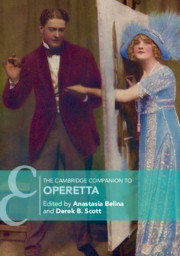Book contents
- The Cambridge Companion to Operetta
- Cambridge Companions to Music
- The Cambridge Companion to Operetta
- Copyright page
- Contents
- Illustrations
- Tables
- Music Examples
- Notes on Contributors
- Chronology, 1855–1950
- Introduction
- Part I Early Centres of Operetta
- Part II The Global Expansion of Operetta
- 6 Going Global: The International Spread of Viennese Silver-Age Operetta
- 7 Spain and Zarzuela
- 8 Camping along the American Operetta Divide (on the Road to the Musical Play)
- 9 Operetta in Russia and the USSR
- 10 Operetta in the Nordic Countries (1850–1970)
- 11 Operetta in Greece
- Part III Operetta since 1900
- Select Bibliography
- Index
- References
10 - Operetta in the Nordic Countries (1850–1970)
from Part II - The Global Expansion of Operetta
Published online by Cambridge University Press: 14 November 2019
- The Cambridge Companion to Operetta
- Cambridge Companions to Music
- The Cambridge Companion to Operetta
- Copyright page
- Contents
- Illustrations
- Tables
- Music Examples
- Notes on Contributors
- Chronology, 1855–1950
- Introduction
- Part I Early Centres of Operetta
- Part II The Global Expansion of Operetta
- 6 Going Global: The International Spread of Viennese Silver-Age Operetta
- 7 Spain and Zarzuela
- 8 Camping along the American Operetta Divide (on the Road to the Musical Play)
- 9 Operetta in Russia and the USSR
- 10 Operetta in the Nordic Countries (1850–1970)
- 11 Operetta in Greece
- Part III Operetta since 1900
- Select Bibliography
- Index
- References
Summary
During the long nineteenth century, the Nordic countries witnessed economic growth, the industrial revolution and the prominent expansion of the bourgeois classes. The growing need for entertainment explains the popularity and increase in production of operettas from the 1850s onwards. Jacques Offenbach and his satirical operettas enjoyed success in Copenhagen at the Folketeatret. During the great Lehár craze, Danish performers toured Scandinavian cities. By the 1870s, Christiania (now Oslo) in Norway also had an operetta epidemic, and new venues opened for the active Danish and Swedish companies and some domestic initiatives. The first production of Offenbach’s Orfeus i underjorden in Stockholm was staged by Pierre Deland in 1860. An elegant new venue, the Oscarsteatern (built in 1906) had its first major success with Lehár’s Den glada änkan in 1907. A Swedish Theatre was erected in Helsinki 1860 and opened with Deland’s production of Orfeus i underjorden. Helsinki also accommodated Russian officers and their families, who found entertainment first in the Arkadia-theatre, where several Russian-language operetta productions were given. Operettas in Finnish found their best home at the Kansan Näyttämö (People’s Stage) founded in 1907 in Helsinki.
- Type
- Chapter
- Information
- The Cambridge Companion to Operetta , pp. 149 - 166Publisher: Cambridge University PressPrint publication year: 2019



